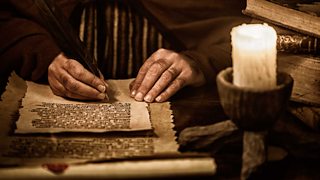Eight weird and wonderful medieval remedies for illness
Looked at from 1000 years away the history of medicine can seem like a litany of stupid, irresponsible treatments, probably performed by sadists. But Anglo-Saxon medicine has recently begun to be reappraised.
Their medical books were called leechbooks, but they don’t actually have anything to do with leeches. The most well-known old English text Bald's leechbook contains recipes for antimicrobial salves! So what did the Anglo-Saxons really know? Naomi Alderman has been finding out in Science Stories.
We strongly recommend you do NOT try these at home!
1. To treat swollen eyes
One leechbook suggests tying a live crab around the neck.
To treat swollen eyes tie a live crab around the neck.
2. Very superstitious?
Place a water plant under the pillow at night to protect the patient from the devil.
3. A remedy for an eye infection
Not all the advice in leechbooks is to be taken with a pinch of salt. One remedy from Bald's Leechbook has been proven to kill the antibiotic-resistant hospital superbug MRSA. Take crop-leek (an onion from the allium species) and garlic of both equal quantities. Pound them well together. Take wine and bullock’s gall or bile. Mix with the leek. Let the mixture stand for nine nights in a brass vessel. Wring through a cloth and clarify well. Put in a horn and at night apply to the eye with a feather.
4. During pregnancy
One Anglo-Saxon leechbook suggests that pregnant women should avoid salty food, alcohol and vigorous exercise.
5. To treat infections
Many leechbook medicines to treat swollen infected parts of the body include copper salts which kill cells but would have probably killed off the infection before doing the patient lasting harm.
6. Belly wound
There’s a recommendation that if a person is wounded in the belly and their bowels are poking out, the physician should replace the bowels and sew the wound up with silk, what was then a fairly recent import from China. This is actually very smart advice – the silk would dissolve as modern stitches do, meaning that they wouldn’t have to be removed.
7. Helping an enlarged spleen
There are even cleverer remedies in some leechbooks. One problem in Anglo-Saxon England, believe it or not, was malaria. We hadn’t drained our marshes yet so in the wet areas of the country malaria was endemic. One consequence of malaria is anaemia, which can cause the spleen to become enlarged. So Bald’s Leechbook suggests that a remedy for an enlarged spleen is: take a very hot iron rod, just out of the fire. Plunge it into wine or vinegar, give the liquid to the patient to drink. The liquid that had had a poker cooled in it would have been iron-rich, and would indeed have helped with the anaemia, which would have been the very common cause of an enlarged spleen. One can only imagine what process of trial and error led to that discovery.
8. To cure night blindness
Nyctalopia of the eyes - that is, one who cannot see after sunset until sunrise. Roast buck liver, from which a liquid flows out when it is roasted. Anoint the eyes with it and give the liver itself to be eaten. Night blindness is caused by Vitamin A deficiency. Liver is very rich in Vitamin A. This buck liver treatment probably would have cured most cases of night blindness an average physician would have encountered. But then again, this treatment is immediately followed up by the suggestion that another good cure for night blindness is dung in the eye.

What is a leechbook and how were these compendiums compiled?

What would you do if you were ill in medieval times?

How far can medieval remedies go towards helping us fight antibiotic resistance?
-
![]()
Science Stories
Naomi Alderman opens the pages of medieval recipe books to find antimicrobial salves.
-
![]()
Seven strange facts about the world's toughest plants
We’ve uncovered some surprising facts about some of our hardiest plants.
-
![]()
Nine out of this world facts about the Moon
Here are some staggering facts about our benevolent protector in the night sky.
-
![]()
Tardigrades are the stuff of sci-fi movies
These microscopic animals are probably the closest thing to an alien we are likely to encounter.




